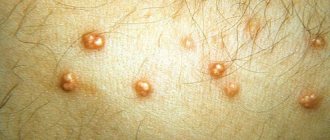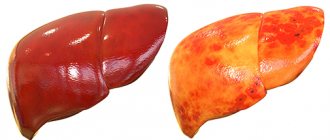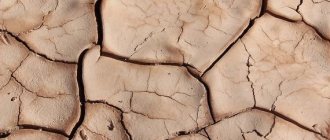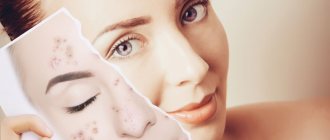Hair, skin, and nails depend on the condition and functionality of the liver. Therefore, the liver and age spots on the face are interconnected things, since it is the good functioning of the gland that determines the “purity” of the skin.
Unsightly defects can be eliminated with whitening cosmetics, laser and cryotherapy, and rejuvenation procedures. However, these options do not guarantee that the stains will not appear again.
The development of liver pigmentation is based on disruption of the liver. That is why treatment involves establishing the exact cause of their appearance and influencing the original source of the problem.
Why liver spots appear on the skin of the face, chest, upper and lower extremities, how treatment is carried out - hardware techniques and folk remedies - we will consider in detail.
What explains the skin manifestations?
If the liver for some reason can no longer cope with its functions, the skin suffers first. At the same time, itching of the skin in liver diseases is one of the earliest and most characteristic symptoms of the disease. Later, spots on the skin and a rash appear, and only after some time (from a month to several years) other symptoms appear (darkening of the urine, disruption of the intestines, pain in the right hypochondrium, etc.). Why do liver disorders so quickly affect the condition of the skin?
The main reason is an increased amount of toxic substances that circulate in the blood. A healthy liver has time to filter out toxic substances that enter the body. However, with inflammation, proliferation of connective tissue and partial replacement of liver tissue with fat, the ability to neutralize harmful substances is significantly reduced. The body is not only unable to effectively deal with toxins, but also begins to poison itself - with liver diseases, the digestion and assimilation of food significantly deteriorates, which begins to ferment in the intestines, causing putrefactive processes.
It is not difficult to guess that sooner or later the products of decay and fermentation in the intestines will end up in the blood and lymph, which will immediately affect not only the condition of the skin, but also the nervous system. It is the large amount of toxins in the blood that explains poor sleep, fatigue, irritability and lack of focus.
As we found out, with general intoxication of the body due to liver disease, symptoms such as spots on the skin occur. However, itching often occurs. It can occur on any part of the body, but is most often noted on the patient's palms and soles. This symptom is not an independent disease, as many may initially think.
With stagnation of bile, caused by spastic conditions of the sphincters of the bile ducts, the blood is saturated with its salts, which cause a feeling of itching.
General recommendations
It is necessary to limit your time in the sun and avoid solariums. In the summer, use products to protect against ultraviolet exposure, choosing cosmetics with SPF of at least 30. To prevent spots, regularly use face care products that contain antioxidants.
You need to pay attention to nutrition and liver condition. Malfunction of the gland leads to the appearance of liver pigmentation, therefore, along with the removal of spots, it is necessary to undergo treatment for the diagnosed disease.
Clinical picture
Of course, rashes and itching are not always caused by liver diseases - these symptoms may indicate allergies, parasitic and dermatological diseases, etc. How can you understand the cause of spots and itching? You should pay attention to accompanying symptoms. We will tell you what features the skin and general manifestations of liver diseases have.
Types of skin manifestations
Skin manifestations of liver diseases are usually expressed in the form of a rash, acne, redness of large areas of the skin, small reddish dots, and vascular networks.
Less commonly, skin rashes due to liver disease look like age spots on the body. A characteristic symptom of liver dysfunction is severe itching of the skin.
Psoriasis may also occur. With psoriasis, small pinkish spots appear on the skin (usually on the face), on which a scaly crust appears over time. Such spots are painless, but they greatly spoil the appearance, and the very fact of their appearance indicates that the body is in desperate need of help.
Itching of the skin of the body occurs before the appearance of the rash, or simultaneously with it. Skin itching in liver diseases does not have specific localization points - almost the entire body can itch. It is weak at first, but gets stronger over time
Often the itching begins to bother you at night, when the patient is relaxed and cannot distract himself from his own sensations. Often the patient’s skin itches so much that he cannot sleep all night, which significantly affects the quality of life in general.
It is worth noting that skin rashes are often not the cause of itching, but its consequence.
By scratching the skin, the patient introduces infection into the hair follicles, which is why point inflammation appears. The inflamed areas itch many times more, and the patient scratches them again. Violation of the detoxification function of hepatocytes additionally contributes to the development of the inflammatory reaction, as a result of which the rash in liver diseases can be bothersome for a very long time, despite attempts to treat with topical drugs.
Associated symptoms
In addition to skin manifestations, there are also a number of symptoms that you definitely need to pay attention to. If they are combined with skin manifestations, you can without much doubt go for an examination with a gastroenterologist or hepatologist. We list the most common of them:
- nausea, vomiting;
- decreased appetite;
- constipation and diarrhea;
- coated tongue, often with teeth marks;
- pain in the right side (can be both local tingling and widespread pulling);
- increased sweating;
- yellowness of the sclera of the eyes and skin;
- low performance, apathy and lethargy;
- irritability and poor sleep;
- red palms;
- the appearance of transverse stripes on the nail plates;
- thickening of the tips of the fingers and toes (like drumsticks);
- Some liver diseases in men cause gynecomastia (breast enlargement), as well as a decrease in the amount of body hair.
If at least some of the listed symptoms appear in combination with skin manifestations, we can most likely talk about a serious liver pathology.
Diagnostics
One of the most informative and at the same time accessible methods for diagnosing liver condition is a biochemical blood test. It allows you to detect various components of bile in blood serum, as well as fragments of destroyed hepatocyte membranes.
In case of liver disease, the following changes are observed in the biochemical blood test:
- increased levels of bile acids;
- increased bilirubin content;
- increased cholesterol levels;
- the presence of alkaline phosphatase, leucine aminopeptidase and 5'-nucleotidase in the blood serum;
- increased transaminase concentration.
If any of these markers are detected in the patient’s blood, the doctor will refer him for additional studies to determine the cause of these disorders. So, an ultrasound examination of the liver may be required. With an ultrasound examination, you can not only obtain an image of the liver and determine its size, but also visualize the bile ducts: with cholestasis, they will be expanded above the blockage site.
If the doctor suspects the presence of viral hepatitis, you will have to undergo additional testing. A blood test for markers of viral hepatitis is a search in the blood serum for immunoglobulins characteristic of these diseases. These are specific protective proteins that are released when an infection enters the body to neutralize it. Each type of infection has its own type of antibody.
If an abscess or cancer is suspected, an x-ray examination is performed. Computed tomography and magnetic resonance imaging make it possible to obtain truly high-quality layer-by-layer visualization of any organ, therefore this diagnostic method is also actively used in the diagnosis of liver diseases. However, the main disadvantage of this study is its high cost, which somewhat narrows the range of patients.
If it is necessary to clarify the diagnosis, a liver tissue biopsy may be prescribed. Patients are very wary of diagnostic procedures of this kind, because a biopsy is an invasive method that involves taking a small sample of tissue using a special needle. However, this approach is fully justified if other diagnostic methods turn out to be uninformative, and a person’s health and life are at risk.
Treatment of age spots in liver diseases
Before removing stains using a laser or specialized drugs, it is recommended to visit a doctor and examine the liver and gastrointestinal tract for pathological processes. Leveling the external defect does not in any way affect the root cause of its appearance; the likelihood of relapse is high.
Elimination of the cause of occurrence
When the cause of pigmentation on the face is liver disease, the spots will appear again and again after each removal. It is necessary to look for the cause and influence it. When you get rid of liver disease, the spots may go away on their own.
To find the cause, you need to undergo a series of examinations - laboratory tests of blood, urine, feces and instrumental studies - computed tomography, ultrasound, MRI, fibroscanning (if cirrhosis is suspected), biopsy.
Cryodestruction
Cryodestruction helps to get rid of liver spots - the elimination of pathological elements with the help of vital nitrogen. For complete removal, 1-2 procedures are enough.
The process is as follows: the doctor applies liquid nitrogen to the spots with a special sprayer or cotton pad.
Advantages of the technique:
- Fast stain removal, easy technique.
- No blood or tissue scarring.
- A painless option to fix the problem.
- Minimal trauma.
- No special care is required after the procedure.
The disadvantages of cryotherapy include fairly long healing - within 3 weeks, and the presence of contraindications.
Photorejuvenation
Phototherapy is an effective and modern way to get rid of pigmentation.
According to the description of the procedure, the skin is exposed to impulses that destroy melamine accumulations.
Radiation is completely safe for humans. After manipulation, the treated area darkens, then exfoliates, is renewed, and the shade is evened out.
Advantages of photorejuvenation:
- Safety. Phototherapy does not injure tissue, so the formation of scars and the addition of an infectious process are excluded.
- Painless. During treatment, the patient feels a slight burning or tingling sensation. In case of severe pain, it is possible to numb the treated areas.
- Short recovery period. After phototherapy, you should not be in the sun or use cosmetic creams. Recovery takes 3-5 days.
- Productivity. You can remove a stain of any size, regardless of location.
Since the liver and facial pigmentation are related, phototherapy cannot guarantee 100% recovery if the diseased gland is not treated.
Laser removal
Modern laser treatment helps to get rid of even the darkest stains; the procedure is carried out by a doctor. The removal process includes several steps:
- A special preparation in the form of a gel is applied to the surface of dark areas, which ensures close contact between quantum rays and the epidermis.
- The affected area is irradiated using a laser.
- An antiseptic solution is applied to the treated area.
- To prevent scar formation and speed up regeneration, cover the treatment site with a sterile bandage with antiseptics.
The technique has contraindications - mental disorders, elevated body temperature, malignant neoplasms, pathologies of the cardiovascular system, organic lesions of the central nervous system.
Folk remedies
Unconventional methods help clear the skin of stains that appear due to liver disease.
The following home cleansing options are effective:
| Sorrel | A compress of fresh sorrel whitens the skin. It is necessary to grind it into a pulp, put it on a gauze napkin, and apply it to the affected area for 15 minutes. The manipulation is repeated every 2-3 days until the defect disappears completely. |
| Avocado | Herbal ingredients effectively whiten the skin. Rub the pulp into age spots. |
| Lemon + egg white | Mix lemon juice with egg white in equal proportions and apply to the affected areas using a cotton pad. |
| Vinegar + onion | Onion juice and vinegar are mixed in equal proportions. The liquid is applied to age spots once a day. |
| Elder | You need to pour a tablespoon of dry plant into 200 ml of boiling water, leave for 5 hours, filter 2 times. The resulting solution is used for compresses - 2-3 times a day for 15 minutes. |
| Chickweed | A decoction is prepared based on the plant, and the affected areas are wiped with it several times a day. |
Possible diseases
Itching, rashes, spots on the skin and other similar symptoms are often caused by the following liver pathologies:
Inflammation of parenchymal hepatocytes
This group of diseases includes infectious lesions of hypatocytes (viral and bacterial hepatitis, parasitic diseases), toxic lesions (poisoning with alcohol, mushrooms, spoiled foods, medications, etc.), as well as cirrhosis. Affected hepatocytes do not perform their functions, which leads to bile acids entering the bloodstream. This causes skin reactions (burning and itching).
Itching is one of the first manifestations of hepatocyte damage. So, with biliary cirrhosis, most often it is the itching that forces the patient to visit a doctor.
In addition to itching, patients with hepatocyte lesions may experience dull pain in the right hypochondrium. It is also possible to develop hepatic jaundice.
Cholestasis
Cholestatic syndrome is a pathological condition that consists of a decrease in the flow of bile into the duodenum. The reason may be either a violation of its production or the inability to excrete it due to obstruction of the biliary tract. The development of cholestasis can be triggered by infections, endocrine disorders, congenital metabolic disorders, cysts or tumors in the biliary tract, parasitic infestations of the liver, etc.
As a result of the inability to excrete bile, excess bile acids are absorbed from the gallbladder into the blood, which leads to the development of skin reactions.
Cholestasis is one of the most common causes of itchy skin. This symptom is experienced by every fourth patient with cholestasis.
The skin with cholestasis is initially yellowish and then acquires a greenish tint. The pain in the right side can be quite intense. Other signs of the disease are nausea, fatigue, irritability, and poor sleep. Possible increase in body temperature.
Side effect of drugs
Some medications have a negative effect on the condition of hepatocytes - this property is called “hepatotoxicity”. In addition, some antibiotics, as well as hormonal drugs (including hormonal contraceptives) can disrupt the flow of bile. This causes a number of characteristic symptoms - itching, burning of the skin, and the appearance of rashes.











